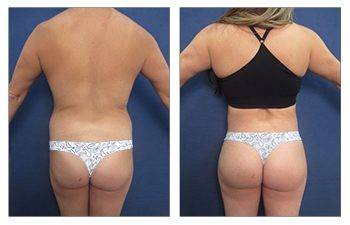
Both procedures aim for fullness—but the method and feel are different
Butt implants and fat transfer both add volume, but how they do it couldn’t be more different. Implants are silicone devices placed inside or under the muscle. Fat transfer, often called a Brazilian Butt Lift (BBL), uses your own fat from elsewhere on the body.
Implants provide a fixed shape and size. Fat transfer is softer, more natural to touch—but less predictable. Fat can be reabsorbed. Implants do not. Each method creates projection, but the experience afterward can feel dramatically different.
Knowing how you want to feel is as important as knowing how you want to look.
Implants give consistent size—fat transfer adapts to your body
With implants, you choose the size in advance. The result doesn’t rely on your fat stores. Even patients with low body fat can achieve roundness and projection.
Fat transfer depends on how much fat you have. Not everyone has enough for a BBL. Even if they do, not all of it survives. Some is reabsorbed by the body. This can change the outcome—sometimes subtly, sometimes significantly.
One gives volume with certainty. The other gives softness with variability.
Fat transfer shapes more than the butt
BBL begins with liposuction. Fat is taken from the waist, stomach, or thighs. This contouring reshapes the body, not just the buttocks. The waist looks smaller. The curve becomes more dramatic.
Implants add size only where placed. There’s no contouring. No redistribution. You get a fuller butt—but your waistline, hips, and other areas remain the same.
For some, that’s enough. For others, the missing contour makes the difference feel incomplete.
Implants are firm and fixed—fat feels more natural
Because implants are solid silicone, they remain firm. Some describe them as too firm. They don’t shift with movement. They sit in place, holding shape, resisting pressure.
Fat, being soft tissue, moves. It feels like the rest of your body. It jiggles. It ages with you. But it’s also more vulnerable—affected by weight change, hormones, and time.
The touch, the motion, the softness—fat mimics the body. Implants remind you something’s been added.
Healing from implants is longer and riskier
Implants involve more invasive surgery. An incision is made, often between the buttocks. The pocket for the implant is created in or under the muscle. Recovery is longer. Pain is more intense. Risks include shifting, infection, and rejection.
BBL recovery still requires care—no sitting, sleeping on your side, or pressure on the area. But it’s less painful. There’s no large internal device. The body heals from fat reabsorption, not hardware integration.
One recovery demands endurance. The other demands patience.
Implants may need to be replaced—fat doesn’t
Implants can rupture, shift, or wear down over time. Many patients require revision surgery after 10–15 years. Some sooner. That means planning for future procedures.
Fat, once it survives, becomes part of your body. It stays. It grows or shrinks with weight. It doesn’t expire. But it also doesn’t guarantee symmetry or permanence.
No touch-up needed sounds appealing—until you realize how often implants need adjusting.
Fat transfer results evolve—implants stay the same
After a BBL, you won’t know your final shape for months. Swelling hides the real result. Then some fat is lost. What remains is long term—but unpredictable. One cheek might hold more. One hip might dip.
Implants don’t change. They sit, unchanged, over years. But they also don’t adapt. The body changes. Weight shifts. Skin loosens. Implants don’t follow.
The question is: do you want a shape that lives with your body—or sits apart from it?
Fat transfer offers full-body change—implants offer one-location improvement
BBL redefines silhouette. You lose inches in some places. Gain volume in others. It’s not just a new butt—it’s a new waistline.
Implants improve the area they touch. That’s it. They don’t change the rest of the figure. That makes them ideal for lean patients—but limited in their global impact.
Some patients want a single change. Others want harmony. It depends on the vision.
Not every surgeon offers both procedures
Many plastic surgeons perform BBLs. Fewer perform butt implants. The training, tools, and demand differ. Some discourage implants entirely. Others see them as essential options.
Your options depend on your provider. So does your safety. The right surgeon should explain what works for your frame—not just what’s popular.
The choice should come after a conversation—not a trend scroll.
One isn’t better—it’s about match
Implants aren’t worse. Fat transfer isn’t better. They’re tools. The right one fits your body, your goals, your lifestyle.
If you want certainty, implants offer it. If you want natural movement, fat delivers. If you’re lean, implants may be your only choice. If you have fat to spare, BBL might shape more than you expect.
What matters most is the match between your body and your decision—not the trend.
